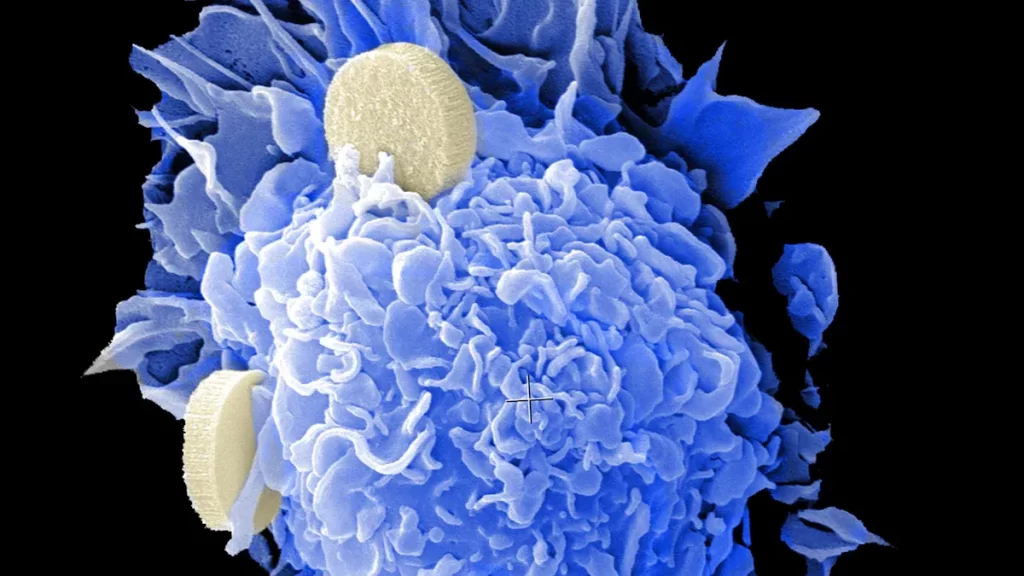News & Events
DNA Antibody Insights You Can’t Miss This Year
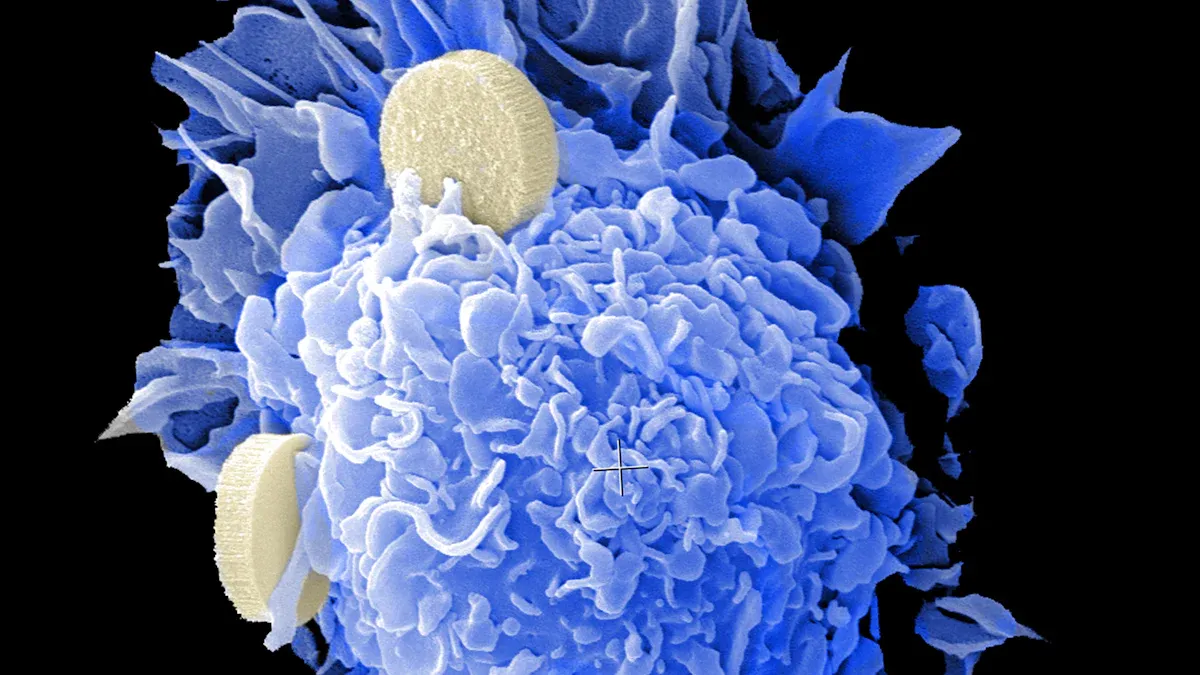
You encounter dna antibody testing when doctors check for lupus. A dna antibody has a special role in your immune system. In 2024, experts define it by its ability to bind both dna and certain proteins. This dual action helps doctors spot autoimmune diseases like lupus quickly. You see its impact in clinics and labs, where accurate detection guides treatment and research.
Key Takeaways
- DNA antibodies play a crucial role in diagnosing autoimmune diseases like lupus. Doctors use these tests to identify and monitor disease activity.
- The structure of DNA antibodies, including heavy and light chains, determines how effectively they bind to DNA. This binding is essential for the immune response.
- Different types of DNA antibodies have varying specificities. For example, anti-dsDNA antibodies are highly specific for lupus, making them vital for diagnosis.
- Emerging therapies using engineered antibodies show promise in treating autoimmune diseases. Patients should discuss these options with their doctors for better symptom control.
- Staying informed about advancements in DNA antibody research can enhance understanding and improve healthcare outcomes. Resources like Antibodypedia can provide valuable insights.
DNA Antibodies
What Are DNA Antibodies
You find dna antibody tests in many clinics today. These antibodies recognize and attach to dna inside your body. Your immune system uses them to spot changes or threats. When antibodies target your own dna, you may face autoimmune diseases. You see this in lupus, where dna antibody levels help doctors track your health. The diversity of antibodies lets your body respond to many signals. You notice that each antibody has a unique shape. This shape gives it specificity, so it can find and bind to certain dna pieces. You learn that specificity helps doctors know which disease you might have. The diversity of antibody shapes means your immune system can react to many types of dna.
Tip: You can remember that dna antibodies act like tiny detectives. They search for clues in your cells and help doctors solve medical mysteries.
Types of DNA Antibodies
You discover many types of dna antibodies in research labs. Scientists study their diversity to understand how your body reacts to different dna forms. Here are some common types:
- ssDNA
- elongated B DNA
- bent B DNA
- Z DNA
- cruciform DNA
- individual components of chromatin
You notice that each type shows different specificity. Some antibodies focus on double-stranded dna, while others target single-stranded dna. You see that anti-dsDNA antibodies have high specificity for lupus. They often signal kidney problems. Anti-ssDNA antibodies show less specificity. You find them in many diseases, so they do not always point to lupus.
| Antibody Type | Disease Specificity | Association with SLE | Renal Involvement | Sensitivity |
|---|---|---|---|---|
| anti-dsDNA | High | Strong | Yes | 60% |
| anti-ssDNA | Low | Variable | Possible | 30%-70% |
You learn that the diversity of dna antibodies helps doctors choose the right tests. The specificity of each antibody guides diagnosis and treatment. You see that diversity and specificity work together to protect your health.
DNA Antibody Structure
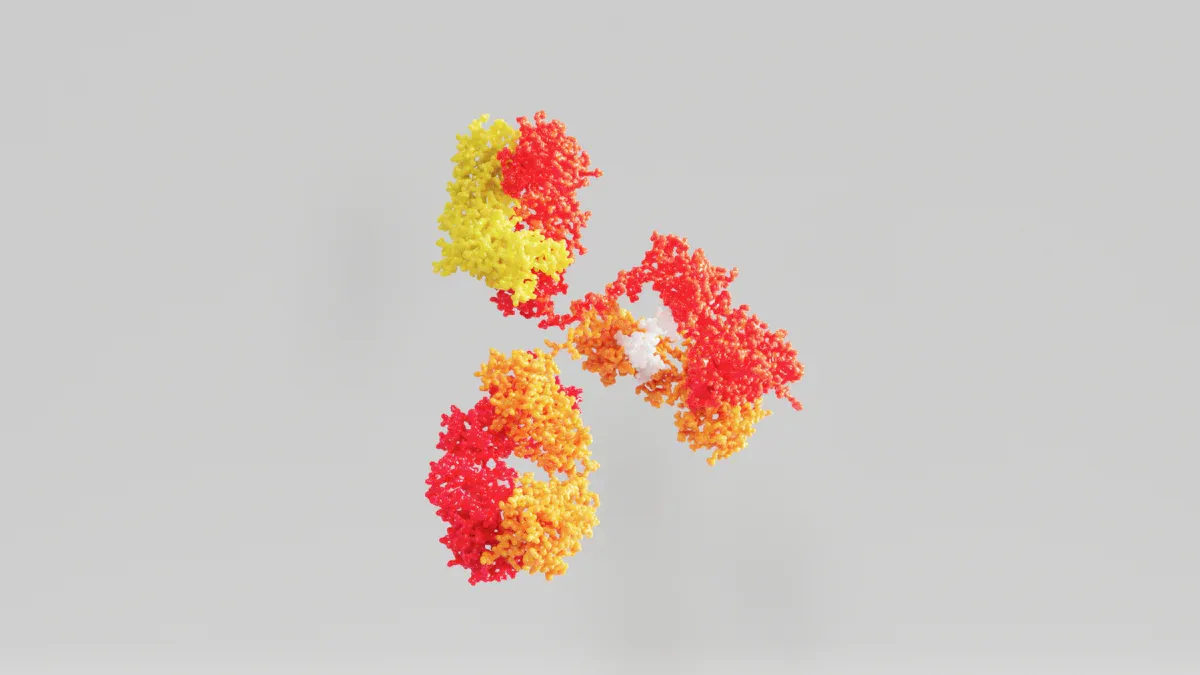
Heavy and Light Chains
You see that antibodies have a special shape. Each antibody contains two main parts: heavy chains and light chains. Heavy chains form the backbone of the antibody. Light chains attach to the heavy chains and help create the binding sites. You find these chains in all immunoglobulins. The arrangement of these chains gives each antibody its unique structure.
- Heavy chains: These are longer and provide strength.
- Light chains: These are shorter and help with flexibility.
You notice that the tips of the chains form the area that grabs onto DNA. This area is called the antigen-binding site. The shape of this site decides which DNA the antibody can recognize.
| Chain Type | Length | Role in Structure | Role in DNA Binding |
|---|---|---|---|
| Heavy Chain | Long | Backbone, stability | Forms part of binding site |
| Light Chain | Short | Flexibility | Forms part of binding site |
Structure and Antibody Function
You learn that the structure of antibodies controls how they work. The way heavy and light chains connect creates a pocket that fits certain DNA shapes. This pocket must match the DNA for the antibody to grab it. You see that the antibody structure decides which DNA the antibody can bind.
The interaction of anti-DNA antibodies with DNA requires a large or extended antigenic structure for stable binding. This is evidenced by the finding that bivalent F(ab’)2 fragments of anti-DNA antibodies, which lack the Fc portion, are unable to bind to DNA, indicating that the Fc portion is crucial for this interaction. Additionally, the binding mechanism involves monogamous bivalency, where both Fab sites must contact determinants on the same extended DNA molecule, further emphasizing the structural requirements for effective binding.
You find that scientists have studied many DNA structures and their ability to trigger specific antibodies. Recent research shows that each DNA structure has unique properties. These properties change how your immune system responds. You see that antibody structure is not just about shape. It also affects how well antibodies bind DNA and how they help your body fight disease.
Antibody Function and DNA Interaction
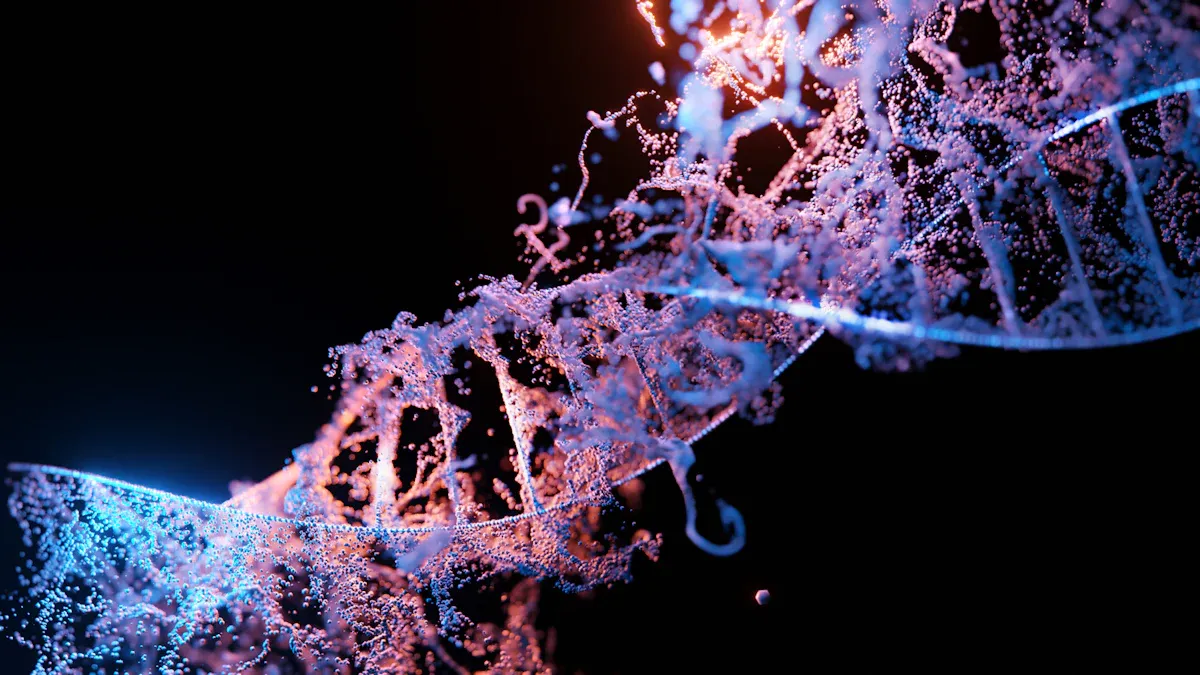
How Antibodies Bind DNA
You see the immune system use antibodies to recognize and bind DNA with remarkable precision. The antigen binding site on each antibody fits the antigen like a puzzle piece. This recognition depends on the structure of both the antibody and the DNA antigen. You notice that anti-double-stranded DNA antibodies can detect even single-base changes in DNA. These antibodies show high affinity for specific DNA antigens, reaching values as strong as 1 x 10⁻⁹ M. When the DNA antigen gets longer, the binding affinity drops and levels off at 2 x 10⁻⁸ M.
You learn that electrostatic forces do not play a major role in antibody-DNA binding. Instead, the antigen binding relies on indirect readout and DNA conformation distortion. Spectroscopic studies reveal that DNA antigens undergo substantial denaturation when antibodies bind. This exposes DNA bases and allows for better recognition. The immune system uses antibody diversity to create many antigen binding sites. Each site recognizes a unique DNA antigen, supporting the multifaceted roles of antibodies in immune defense.
- Antibodies recognize DNA antigens by matching the antigen binding site to the DNA structure.
- The immune system relies on antibody diversity for effective antigen recognition.
- DNA antigens change shape during binding, which helps antibodies perform their functions.
Tip: You can think of antigen binding as a handshake. The antibody and DNA antigen must fit together perfectly for the immune system to work well.
Immune System Role
You observe the immune system use antibodies for several functions. These include neutralization, opsonization, and antigen recognition. In healthy individuals, the immune system keeps antibody function balanced. You find low-affinity IgM antibodies to DNA antigens in circulation. These antibodies help with immune surveillance and antigen neutralization.
In autoimmune conditions, the immune system produces too many antibodies against DNA antigens. You see this in systemic lupus erythematosus (SLE), where antibody function shifts. The immune system switches to IgG antibodies, which can damage tissues. DNA antigens form complexes with antibodies, leading to glomerulonephritis and other problems. The immunogenicity of different DNA antigen forms, such as B-DNA and Z-DNA, increases antibody diversity and enhances immune functions.
| Role of DNA Antibodies | Normal Immune Response | Autoimmune Conditions |
|---|---|---|
| Presence | Low-affinity IgM antibodies circulate. | Overproduction of antibodies causes disease. |
| Types | Both single- and double-stranded DNA antibodies present. | SLE patients show high levels of anti-dsDNA antibodies. |
| Pathogenic Potential | Non-pathogenic in low amounts. | IgG antibodies cause tissue damage and glomerulonephritis. |
You see the immune system rely on antigen binding for neutralization and opsonization. The multifaceted roles of antibodies support immune system functions and protect your body. Antibody function depends on antigen recognition and binding, which keeps the immune system strong and responsive.
DNA Antibodies in Disease
Systemic Lupus Erythematosus (SLE)
You see systemic lupus erythematosus (SLE) as one of the most studied autoimmune diseases. SLE affects many organs and can cause serious health problems. You learn that dna antibody testing plays a key role in SLE diagnosis. Anti-double-stranded dna antibodies are a hallmark of SLE. These antibodies help doctors identify the disease and track its progress.
You notice that anti-dsdna antibodies are present in most SLE patients. Studies show that elevated double-stranded dna antibody levels can be detected in up to 86% of SLE cases. You also find that anti-dsdna antibodies are found in about 70-95% of people with SLE. This high prevalence makes dna antibody testing important for clinical diagnosis.
- Systemic lupus erythematosus
- Sjögren’s syndrome
- Rheumatoid arthritis
- Autoimmune hemolytic anemia
You discover that SLE patients have a higher risk of developing hematological malignancies, especially non-Hodgkin lymphoma. Nearly half of these cases are diffuse large B-cell lymphoma. You see that dna antibody profiles differ between autoimmune diseases. SLE stands out because of its strong link to anti-dsdna antibodies and unique clinical features.
Diagnosis and Monitoring
You rely on dna antibody tests to help diagnose SLE and monitor disease activity. Doctors use several laboratory techniques to detect dna antibodies. Each method has strengths and weaknesses. You find that the Crithidia luciliae immunofluorescence test (CLIFT) offers high specificity but lower sensitivity, especially in early SLE. ELISA and FEIA provide good sensitivity but lower specificity. Chemiluminescence immunoassay (CLIA) balances sensitivity and specificity. Farr’s technique is the gold standard for SLE detection, but it uses radioactive materials.
- CLIFT: High specificity, lower sensitivity
- ELISA: Good sensitivity, lower specificity
- FEIA: Automated, good sensitivity
- CLIA: Balanced sensitivity and specificity
- Farr’s technique: High specificity, uses radioisotopes
- Flow cytometry: Detects free and complexed dna antibodies
You see that the diagnosis of SLE requires meeting four of the 11 criteria set by the American College of Rheumatology. Two of these criteria include the presence of antinuclear antibodies and either anti-dna or anti-Sm antibodies.
| Aspect | Evidence |
|---|---|
| Diagnostic Role | Anti-dsdna antibodies are crucial in the diagnostic criteria for SLE, especially in low pre-test probability populations where high specificity is essential. |
| Monitoring Disease Activity | The level of anti-dsdna antibodies can indicate disease activity and predict clinical relapses, although current assays are not specifically marketed for this purpose. |
| Sensitivity Issues | The sensitivity of anti-dsdna antibodies in SLE is about 60%, prompting the search for additional autoantibodies to improve diagnostic accuracy. |
| Association with Lupus Nephritis | A strong historical association exists between anti-dsdna antibodies and lupus nephritis, which may be affected by changes in assay sensitivity. |
| Need for Standardization | There is a call for multi-center studies to standardize assays for anti-dsdna antibodies to improve diagnostic and monitoring practices in SLE patients. |
You notice that dna antibody levels can help monitor SLE activity. Doctors look for changes in anti-dsdna antibody levels to predict flares. You see that increasing and fluctuating levels may come before disease flares. However, the predictive value of these levels is not always consistent. Factors like ethnic background and laboratory methods can affect results.
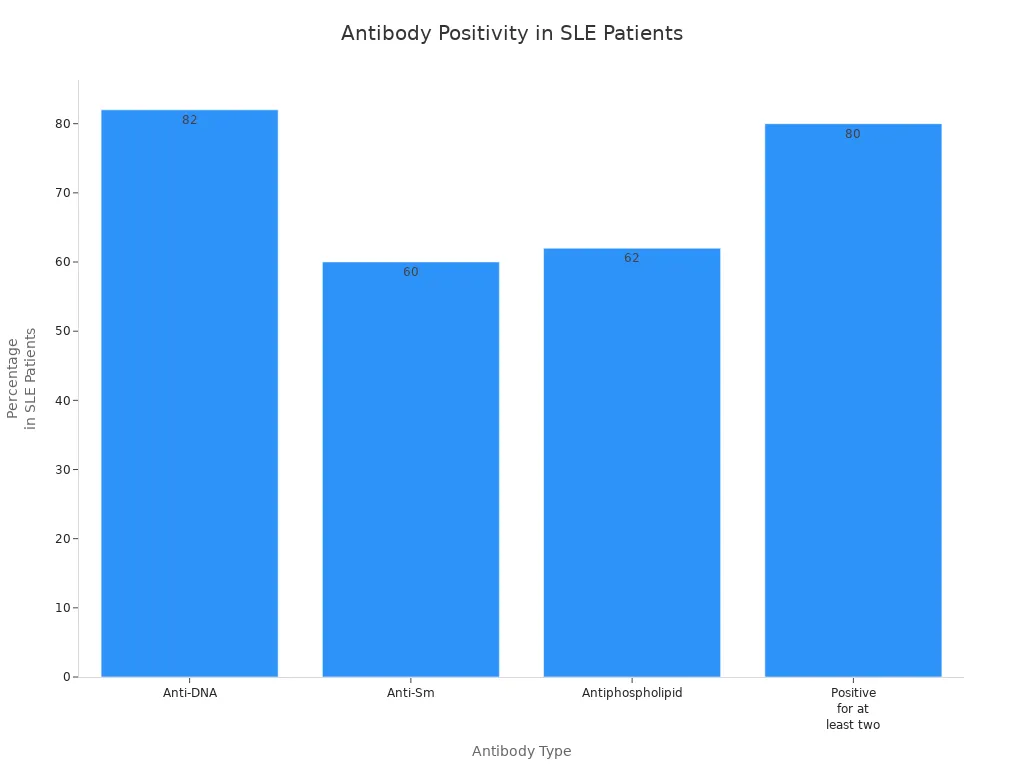
You learn that baseline anti-dsdna levels correlate with proteinuria, a sign of kidney involvement. Anti-dsdna antibodies also show strong associations with serositis, arthritis, and Raynaud’s phenomenon. You see that high dna antibody titers often appear with musculoskeletal symptoms and the presence of antiphospholipid antibodies.
| Clinical Presentation | Association with Anti-dsDNA Titers |
|---|---|
| Musculoskeletal symptoms | Higher titers |
| Presence of antiphospholipid antibodies | Higher titers |
| Neuropsychiatric manifestations | Lower titers |
| Treatment with cyclophosphamide | Lower titers |
You find that current dna antibody testing methods face limitations. Results can vary across different techniques. Some tests have lower sensitivity, especially for early SLE. Manual interpretation and qualitative inspections can make monitoring disease activity difficult. You see that standardization of assays is needed to improve clinical practice.
Prognostic Value
You use dna antibody levels to help predict disease outcomes in SLE. Anti-double-stranded dna antibodies are specific to SLE and correlate with disease activity. You see that rising and fluctuating levels of anti-dsdna antibodies may signal upcoming disease flares. However, the predictive value of these levels is not always clear. Differences in laboratory methods and patient backgrounds can affect results.
- Anti-dsdna antibodies are specific to SLE and correlate with disease activity.
- Increasing and fluctuating levels may precede disease flares.
- Predictive value varies across studies due to ethnic and laboratory differences.
You learn that high anti-dsdna levels often mean more severe disease. These levels correlate with proteinuria, higher neutrophil counts, and increased markers of cellular injury. You see that anti-dsdna is a specific marker of lupus disease activity and has strong associations with clinical symptoms like serositis and arthritis.
| Finding | Description |
|---|---|
| Anti-DNA Antibodies | High levels correlate with severe COVID-19 outcomes. |
| Cellular Injury Markers | Strong correlation with LDH and creatine kinase levels. |
| Neutrophil Counts | Significant correlation with anti-DNA antibody levels. |
| D-dimer Concentration | Correlates significantly with anti-DNA antibody levels. |
You find that the most promising biomarkers for predicting autoimmune disease progression include anti-double-stranded dna, anti-Sm, and anti-ribosomal P antibodies.
| Biomarker Type | Description |
|---|---|
| Anti-double stranded (ds) DNA | Highly specific for SLE, indicating disease activity and progression. |
| Anti-Sm | Associated with SLE, providing insights into disease severity. |
| Anti-ribosomal P | Linked to SLE, useful in predicting organ involvement and disease progression. |
Note: Misinterpretation of dna antibody test results can lead to incorrect diagnoses and unnecessary treatments. You see that limited standardization and the complexity of the antigen make interpretation challenging. You should always consider the clinical context and use multiple tests for accurate prognosis.
Latest DNA Antibody Insights
New Research
You see scientists make big strides in understanding how your body creates antibodies. New technology helps researchers study the genetic basis of antibody production. You notice that hybridomas allow scientists to produce large amounts of specific antibodies in the lab. Antibody sequencing services give you detailed maps of antibody genes. Deep sequencing lets you explore many antibody types at once. These tools help you learn how your immune system responds to different threats.
- Hybridomas help you produce specific antibodies for research.
- Antibody sequencing services show you the genetic code of antibodies.
- Deep sequencing reveals the diversity of antibodies in your body.
Recombinant DNA technology gives you control over antibody gene sequences. You can customize antibodies for special tasks. PCR technology makes it easier to create recombinant antibodies with exact sequences. These advances help you understand how antibodies work and how they fight disease.
Emerging Therapies
You find new therapies that use antibodies to treat autoimmune diseases. Researchers design treatments that target harmful antibodies and protect healthy cells. Some therapies use monoclonal antibodies to block disease pathways. Others use engineered antibodies to remove dangerous molecules from your blood. You see doctors test these therapies in clinical trials. Early results show promise for patients with lupus and other autoimmune conditions.
Tip: You can ask your doctor about new antibody therapies if you have an autoimmune disease. These treatments may offer better control of symptoms and fewer side effects.
What’s Ahead This Year
You can expect more breakthroughs in antibody research this year. Scientists plan to use advanced sequencing to discover new antibody types. You may see faster and more accurate tests for autoimmune diseases. Researchers hope to develop therapies that target disease at the genetic level. You will likely hear about new studies that explain how antibodies function in your body. These discoveries could lead to better treatments and improved health for many people.
You have seen that DNA antibodies play a key role in disease diagnosis and monitoring. Their structure, with unique heavy and light chains, shapes how they bind DNA and carry out their function. DNA antibodies help you track diseases like lupus and guide treatment decisions. The table below highlights important clinical findings from recent studies:
| Key Findings | Description |
|---|---|
| Diagnostic Accuracy | Discordance of positivity between anti-dsDNA assays is common, affecting a fifth of patients overall and a third of visits. |
| Testing Methods | EIA positivity is less associated with lupus nephritis compared to CLIFT positivity. |
| Monitoring SLE | Using both CLIFT and EIA assays may improve classification and routine monitoring of systemic lupus erythematosus (SLE). |
You can use DNA antibody discoveries in healthcare and research in several ways:
- Risk prediction with genomic scores improves early intervention.
- Disease classification allows for tailored treatments.
- Continuous education helps you apply new tests and explain results to patients.
You can stay updated on DNA antibody research by exploring resources like Antibodypedia, CiteAb, and guides on antibody validation. The article “Anti-double stranded DNA antibodies: A rational diagnostic approach in limited-resource settings” also offers valuable clinical strategies. Keep learning as new discoveries shape the function and future of personalized medicine.
FAQ
What are DNA antibodies and why do doctors test for them?
You find DNA antibodies in your blood when your immune system reacts to your own DNA. Doctors test for these antibodies to help diagnose diseases like lupus. High levels often mean your body is fighting itself.
How do DNA antibodies help track lupus?
You see doctors use DNA antibody tests to monitor lupus activity. Rising levels can signal a flare. Stable or low levels often mean your disease is under control. Doctors rely on these tests for better treatment decisions.
Can children have DNA antibodies?
You may notice DNA antibodies in children with certain health problems. Doctors sometimes test kids for these antibodies if they show signs of lupus or other related diseases. Early detection helps doctors start treatment quickly.
Are DNA antibody tests always accurate?
You learn that DNA antibody tests can give different results depending on the method used. Doctors often use more than one test to confirm a diagnosis. This helps reduce mistakes and gives you a clearer picture of your health.
What should you do if your DNA antibody test is positive?
You should talk to your doctor about your results. A positive test does not always mean you have a disease. Your doctor may order more tests or watch your symptoms before making a diagnosis.

